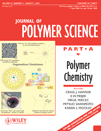β-Cyclodextrin polymer brushes based on hyperbranched polycarbosilane: Synthesis and characterization
Abstract
In this article, our main goal is to combine hyperbranched polymer with β-cyclodextrin (β-CD) to establish a novel functional polymer species with core-shell structure and supramolecular system for further application in inclusion technologies and the complex drugs delivery system. Therefore, two β-CD polymer brushes based on hyperbranched polycarbosilane (HBP) as a hydrophobic core and poly(N,N-dimethylaminoethyl methacrylate) (PDMA) carrying β-CD units as a hydrophilic shell were synthesized. Hyperbranched polycarbosilane macroinitiator carrying Cl groups (HBP-Cl) was also prepared by using 1,1,3,3-tetrmethyldisiloxane, allyl alcohol, and chloroacetyl chloride as reagents. The molecular structures of HBP-Cl macroinitiator and β-CD polymer brushes were characterized by Fourier transform infrared spectroscopy (FTIR), 1H nuclear magnetic resonance (1H NMR), 13C nuclear magnetic resonance (13C NMR) spectroscopies, size exclusion chromatography/multi-angle laser light scattering (SEC/MALLS) and laser particle size analyzer. The results indicate that the grafted chain length of two β-CD polymer brushes can be controlled by changing the feed ratio. Differential scanning calorimetry (DSC) results show that two β-CD polymer brushes have two glass transition temperatures (Tgs) from a hydrophobic core part and a hydrophilic shell part, respectively, and the Tg from PDMA is higher than that of HBP-g-PDMA. Thermalgravimetric analyzer (TGA) analysis indicates that the thermostability of two β-CD polymer brushes is higher than that of HBP, but is lower than that of HBP-g-PDMA. Using phenolphthalein (PP) as a guest molecule, molecular inclusion behaviors for two β-CD polymer brushes were studied. It reveals that two β-CD polymer brushes possess molecular inclusion capability in PP buffer solution with a fixed concentration. © 2008 Wiley Periodicals, Inc. J Polym Sci Part A: Polym Chem 46: 5036–5052, 2008




